London is a vibrant city that boasts abundant birdlife, thanks to its abundant parks, gardens, and water bodies. From the majestic swans of the Thames to the cheeky pigeons that navigate the bustling streets, there are plenty of birds to see in this urban landscape.
In this article, we will explore some of the most common birds found in London and their behavior, characteristics, and habitats.
Whether you are a bird lover or just curious about the avian fauna of this metropolis, join us on this exciting journey through the feathered residents of London.
1. Rose-Ringed Parakeet
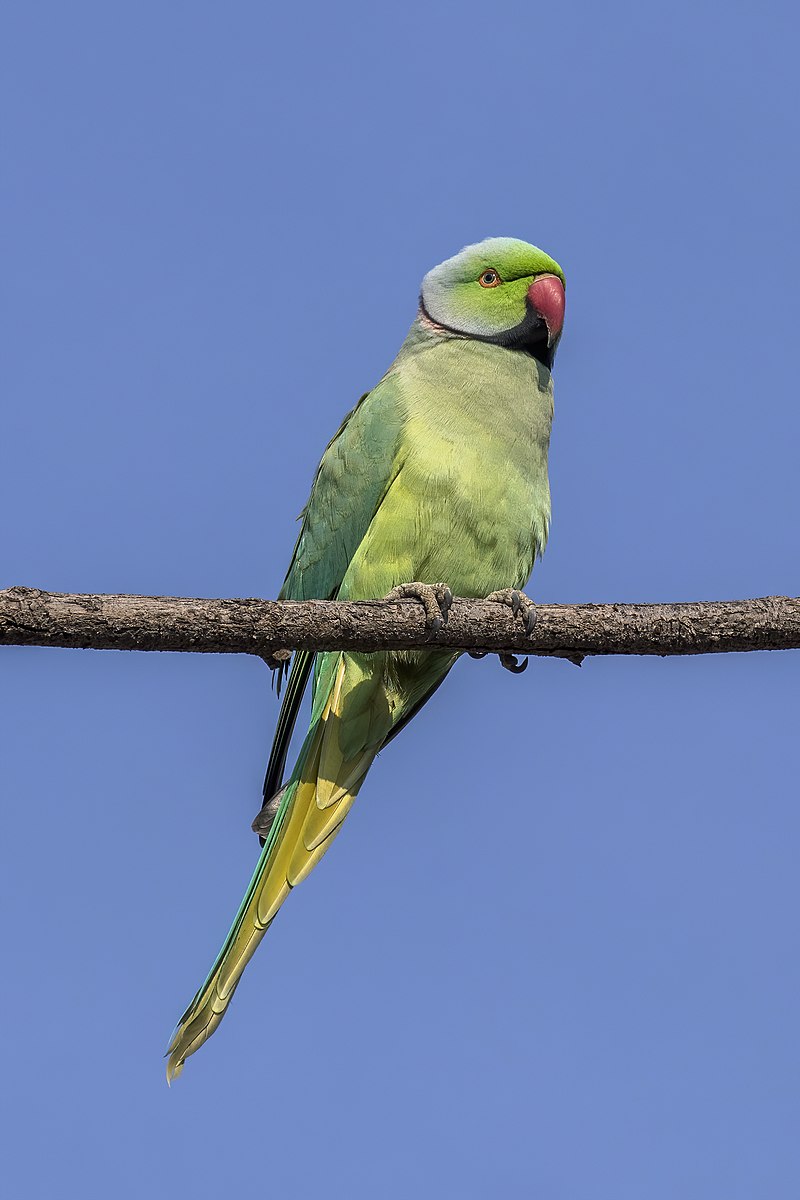
The Rose-ringed parakeet is a medium sized bird in the family Psittacidae. Native to Africa and India, it has been introduced into many other parts of the world where feral populations have now established themselves.
The most distinctive feature of this species is its colorful neck ring ranging from pink to purple which gives them their name.
However, males often display more vibrant colors than females do. This beautiful bird can also imitate human speech quite well making them popular pets worldwide.
In addition they are very social creatures preferring large flocks when out in nature or as part of aviaries during captivity. With proper care these birds can live up to 30 years.
Scientific classification:
| Kingdom | Animalia |
| Phylum | Chordata |
| Class | Aves |
| Order | Psittaciformes |
| Family | Psittaculidae |
| Genus | Psittacula |
| Species | P. krameri |
Also Featured In: Common Birds in India, Common Birds in the Cities
2. Kingfisher
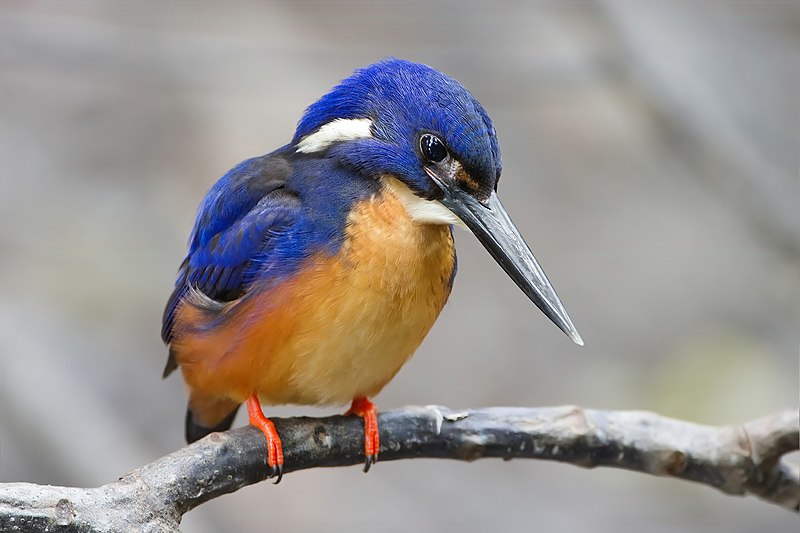
Kingfishers are a vibrant and unique family of birds, with most species found in tropical regions across Africa, Asia, Oceania and Europe.
Their bright colors make them easily identifiable among the foliage of deep forests near calm ponds or rivers.
They come in three subfamilies: tree kingfishers (Halcyoninae), water kingfishers (Cerylinae) and river kingfishers (Alcedinidae).
Kingfisher birds have short legs used for perching along branches overhanging streams or lakes; they also possess strong beaks perfect for catching fish.
These little hunters will remain motionless as if suspended from thin air until an unsuspecting prey comes within reach.
Then they swoop down quickly to grab their meal. With 116 different species making up this incredible family, there’s something special about every single one.
Scientific classification:
| Kingdom | Animalia |
| Phylum | Chordata |
| Class | Aves |
| Order | Coraciiformes |
| Suborder | Alcedines |
| Family | Alcedinidae Rafinesque, 1815 |
Also Featured In: Birds You’ll Find in Moldova, African Birds
3. Peregrine Falcon
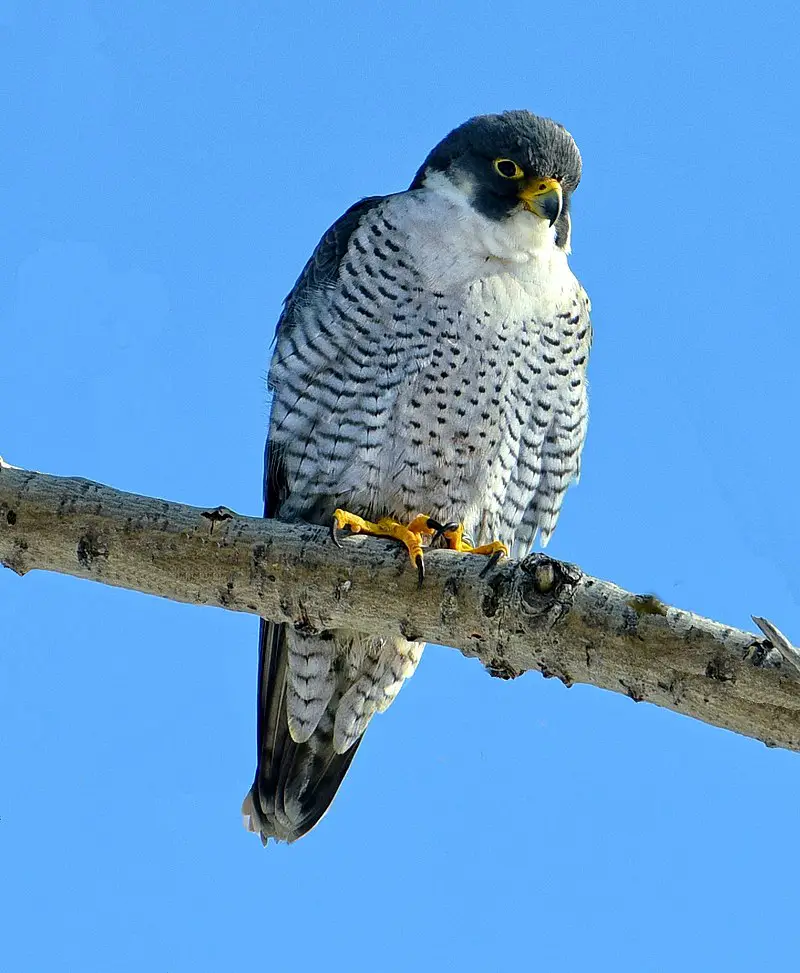
The Peregrine Falcon is a majestic bird of prey belonging to the family Falconidae. It has a blue-grey back, barred white underparts and black head making it easily recognizable.
This intelligent raptor is known for its incredible speed reaching over 320 km/h (200 mph) during hunting dives – one of the fastest animals in existence.
The peregrine falcon can be found around the world from Arctic tundra to tropical rainforests thriving with humans or in high alpine mountains far away from civilization.
With their beauty, power and adaptability they are an impressive species that have earned respect among many cultures throughout history as symbols of strength and endurance.
Scientific classification:
| Kingdom | Animalia |
| Phylum | Chordata |
| Class | Aves |
| Order | Falconiformes |
| Family | Falconidae |
| Genus | Falco |
| Species | F. peregrinus |
Also Featured In: Most Common United States Birds, Birds of Sweden
4. Long-Billed Dowitcher

The Long-billed Dowitcher is a beautiful shorebird with an unmistakable long bill. During breeding season, they are characterized by their rufous head and underparts combined with a dark mottled back and large white upper rump only visible when in flight.
These birds can be found in freshwater habitats all over the world, where they forage underwater using their long bills to seek out aquatic invertebrates such as insects or small crustaceans.
They also feed on plant material like seeds and berries during times of scarcity.
The Long-billed Dowitcher is an important species for ecological balance due to its unique feeding habits that help control populations of certain insect pests, which makes it one of the most valuable bird species around us.
Scientific classification:
| Kingdom | Animalia |
| Phylum | Chordata |
| Class | Aves |
| Order | Charadriiformes |
| Family | Scolopacidae |
| Genus | Limnodromus |
| Species | L. scolopaceus |
Also Featured In: Top Birds Found in Mexico, Birds in Calgary You’ll Love to See
5. Egyptian Goose
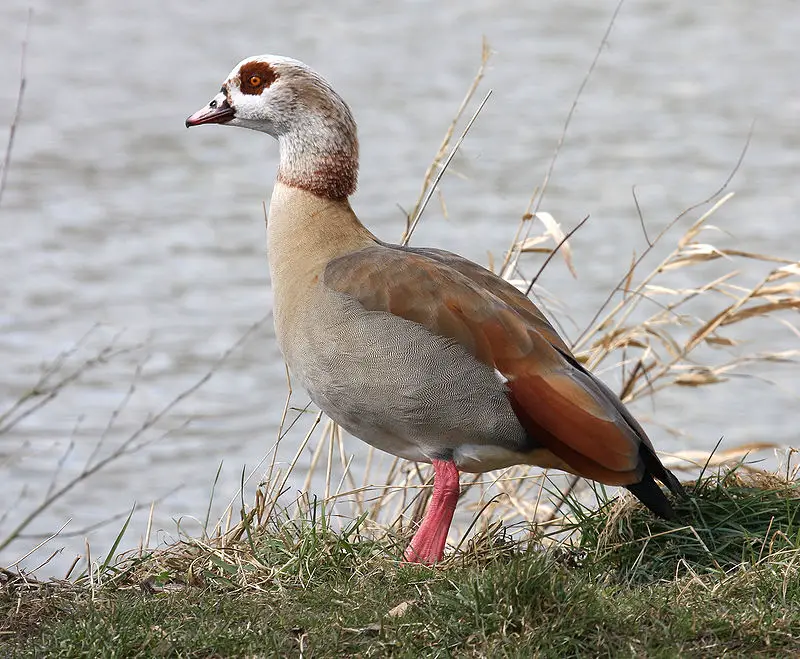
The Egyptian goose is a beautiful bird from the Anatidae family native to Africa. It has long been revered by the Ancient Egyptians, who depicted it in much of their artwork.
Today, these geese are kept as ornamental birds and commonly escape into the wild, resulting in an abundance of feral populations across southern Sahara and Nile Valley regions.
With its grayish-brown body featuring white patches around its neck and tail feathers that range from dark brown to bluish-grey coloration.
This species stands out amongst other waterfowls with its striking appearance which also features bold orange eyes surrounded by blue eye rings – quite remarkable.
As they swim along rivers or roam grasslands searching for food such as grains, fruits & vegetables; they make great additions to both aviary collections or natural habitats alike.
Scientific classification:
| Kingdom | Animalia |
| Phylum | Chordata |
| Class | Aves |
| Order | Anseriformes |
| Family | Anatidae |
| Genus | Alopochen |
| Species | A. aegyptiaca |
Also Featured In: Egyptian Birds, Savanna Birds You Need to See
6. White Wagtail
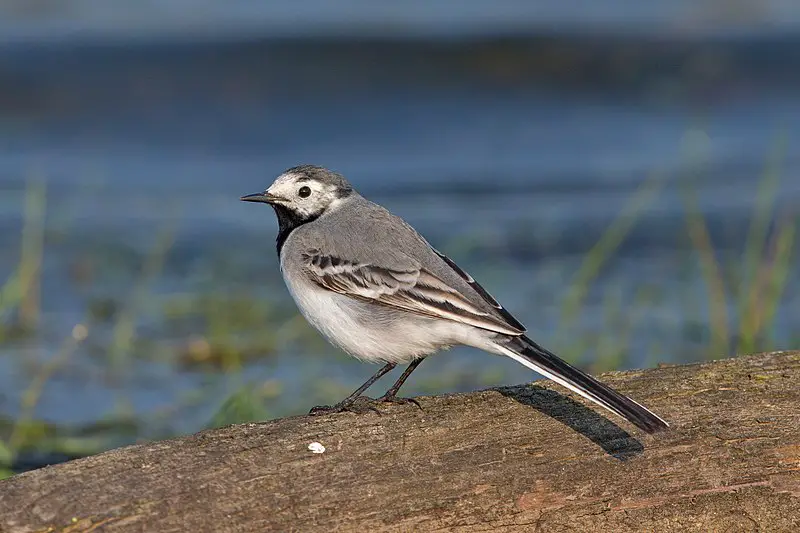
The White Wagtail is a small passerine bird that belongs to the Motacillidae family, which includes pipits and longclaws. This species breeds in Europe, Asia Palearctic and North Africa.
It has also been seen as a scarce breeder in Alaska. Those living in mild climates are found year-round but others migrate south for winter months to Africa.
In Ireland and Great Britain it’s known for its darker subspecies called Pied Wagtails with their distinctive white heads, grey backs and yellow breasts.
They feed on insects such as flies, beetles or spiders by wagging their tail up & down while they walk along surfaces like tree trunks or walls looking out for prey – hence receiving this name.
To attract mates they sing melodic songs from high perches too.
Scientific classification:
| Kingdom | Animalia |
| Phylum | Chordata |
| Class | Aves |
| Order | Passeriformes |
| Family | Motacillidae |
| Genus | Motacilla |
| Species | M. alba |
Also Featured In: Common Slovakian Birds, Birds of Latvia
7. Common Sandpiper
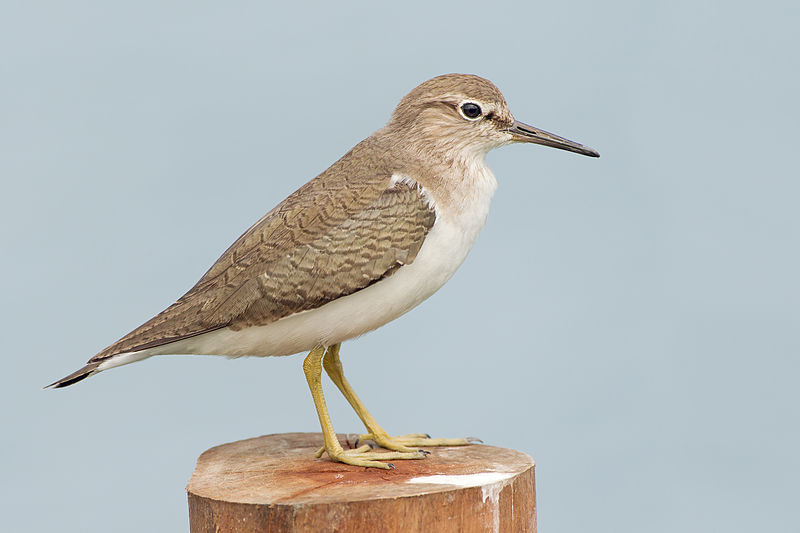
The Common sandpiper (Actitis hypoleucos) is a small Palearctic wader, found in Eurasia and parts of Africa. It can be identified by its brown back, white breast and distinctive black eye-stripe.
In flight it shows broad wings with white underparts and conspicuous dark patches on the upperwings.
These birds live close to water bodies such as rivers or lakes where they feed mainly on insects, crustaceans and molluscs which they find in mudflats.
They are also known to have hybridized with their American sister species – the Spotted Sandpiper (A macularia).
This bird is territorial during breeding season but forms flocks outside of this period when migrating long distances between wintering grounds throughout Europe, North Africa & South West Asia.
Scientific classification:
| Kingdom | Animalia |
| Phylum | Chordata |
| Class | Aves |
| Order | Charadriiformes |
| Family | Scolopacidae |
| Genus | Actitis |
| Species | A. hypoleucos |
Also Featured In: Common Estonian Birds, Birds That Live in Anglesey
8. Great Crested Grebe
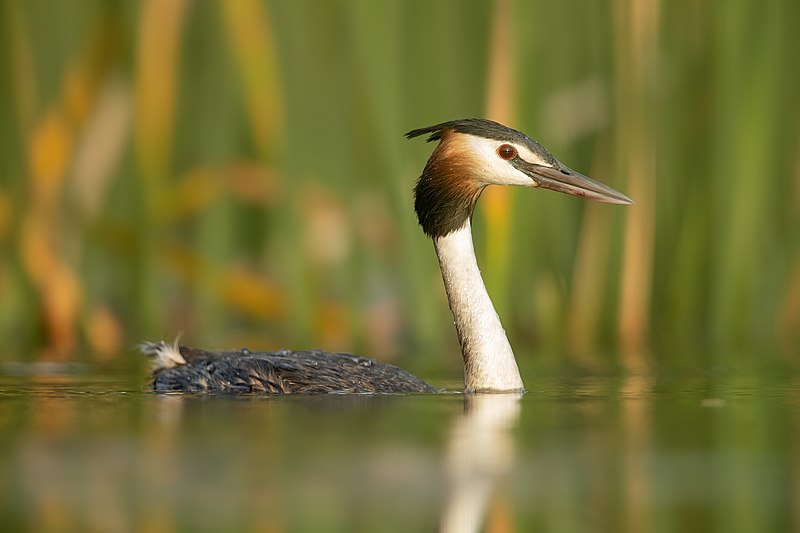
The great crested grebe is a beautiful water bird belonging to the grebe family. It is easily identified by its striking head crest, which it displays during mating rituals.
Originally classified in 1758 by Carl Linnaeus as Colymbus cristatus, this species has since become the type example for all other members of its genus Podiceps.
Great crested grebes are known for their intricate courtship behavior such as synchronized swimming and “head-shaking” motions used to attract mates.
They also possess unique features like red eyes and lobed feet that help them swim efficiently underwater when hunting for food.
The great crested grebe can be found throughout much of Europe, Asia, Africa and Australasia where they inhabit freshwater wetlands or shallow lakeshores with plenty of vegetation nearby to hide from predators while nesting.
Scientific classification:
| Kingdom | Animalia |
| Phylum | Chordata |
| Class | Aves |
| Order | Podicipediformes |
| Family | Podicipedidae |
| Genus | Podiceps |
| Species | P. cristatus |
Also Featured In: Native Birds Of Germany, Belarus Birds You Should Know
9. European Goldfinch
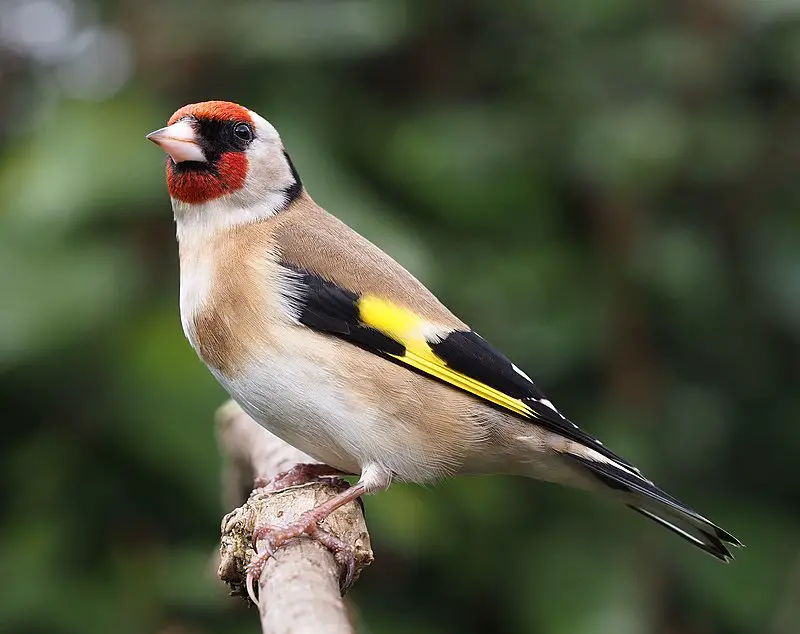
The European Goldfinch is a small passerine bird belonging to the finch family. It inhabits Europe, North Africa, western and central Asia but has been introduced in other places such as Australia, New Zealand and Uruguay.
The breeding male of this species can be easily identified by its red face with black markings around the eyes and black-and-white head.
Its back and flanks are buff or yellowish in color while it has white underparts which contrast well with its dark wings edged in white feathers.
This bird feeds on grains from plants like millet or sunflower seeds along with insects occasionally when available during summer months for food source.
In winter they flock together near sources of water where they find their food among weeds growing there at that time of year.
Scientific classification:
| Kingdom | Animalia |
| Phylum | Chordata |
| Class | Aves |
| Order | Passeriformes |
| Family | Fringillidae |
| Subfamily | Carduelinae |
| Genus | Carduelis |
| Species | C. carduelis |
Also Featured In: Most Common Songs Birds that Live around You, European Birds
10. Coal Tit
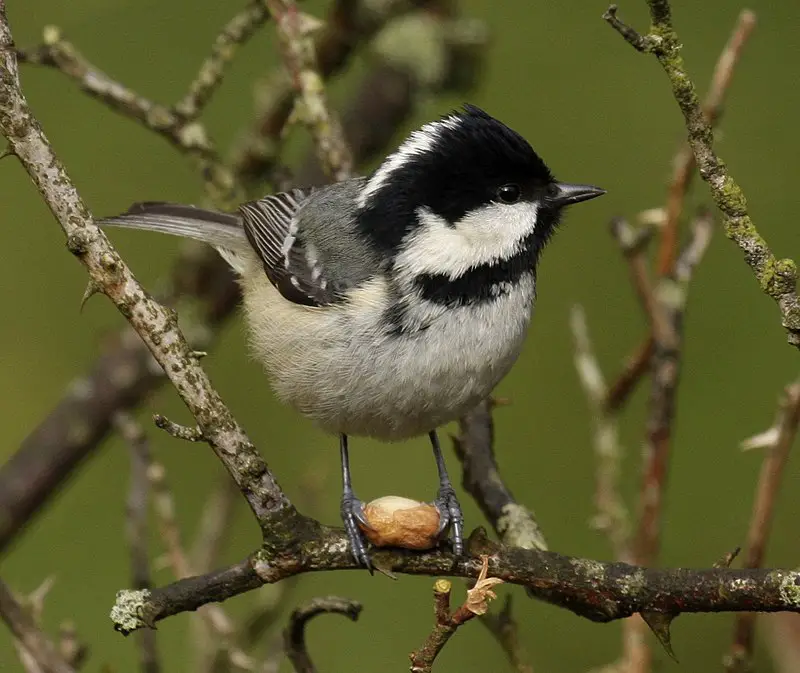
The Coal Tit, also known as the Cole Tit is a small passerine bird belonging to the Paridae family. It has an extensive range, from temperate and subtropical areas in Europe all the way to North Africa.
First described by Carl Linnaeus in Systema Natura back 1758, it’s now commonly grouped with its cousin – The Black-Crested Tit.
This species thrives best when living near forests or other wooded habitats that provide them with plenty of food sources like insects and seeds.
They are considered quite common throughout their range due to their adaptability and resilience which makes them well suited for urban environments too.
Scientific classification:
| Kingdom | Animalia |
| Phylum | Chordata |
| Class | Aves |
| Order | Passeriformes |
| Family | Paridae |
| Genus | Periparus |
| Species | P. ater |
Also Featured In: Birds of United Kingdom, Autumn Birds You Should Know
11. Common Wood Pigeon
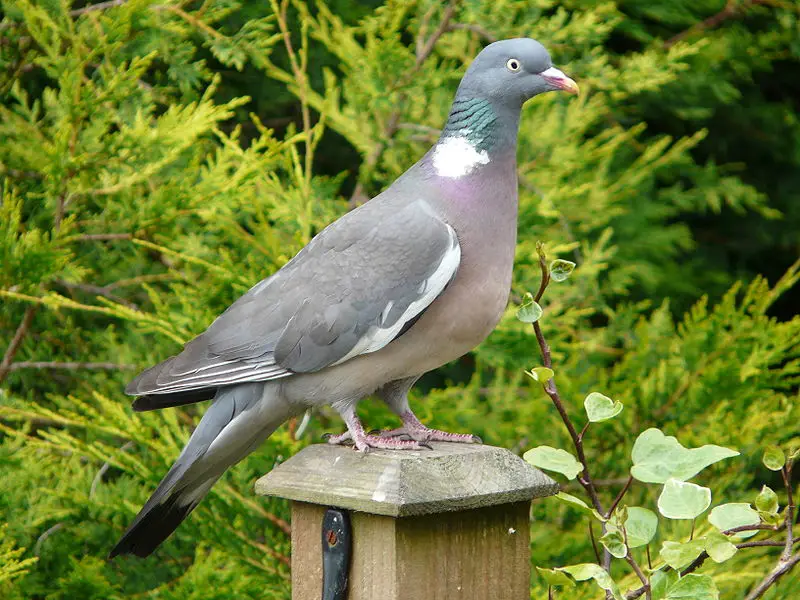
The Common Wood Pigeon is a large bird of the dove and pigeon family, native to the western Palearctic. It has grey plumage with white patches on its wings and neck.
Its head often appears darker than its body due to iridescence in some parts of its feathers. The male woodpigeons have pinkish breasts while females are more brownish-grey coloured.
These birds feed mainly on seeds, fruits, flowers and leaves but will also eat insects when available.
They breed during springtime producing 1-2 clutches per breeding season with two eggs each time which hatch after about 18 days incubation period by both parents taking turns for duty.
They make their nests from twigs collected from nearby trees or places close by and usually raise only one brood at a time making them an important part of nature’s balance as they help keep insect populations under control through their diet choices.
Scientific classification:
| Kingdom | Animalia |
| Phylum | Chordata |
| Class | Aves |
| Order | Columbiformes |
| Family | Columbidae |
| Genus | Columba |
| Species | C. palumbus |
Also Featured In: Common Serbian Birds, Most Common Scotland Birds
12. Dunnock
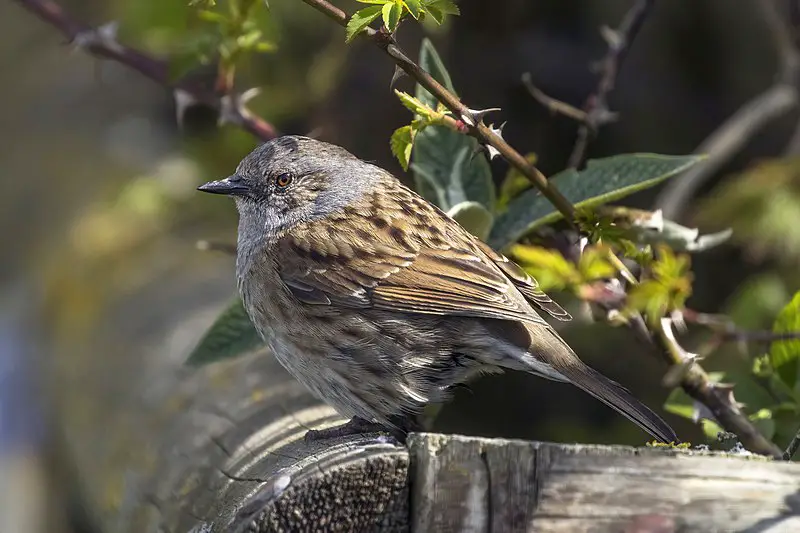
The Dunnock, also known as the Hedge Accentor, Hedge Sparrow and Hedge Warbler, is a small passerine bird found in temperate climates of Europe and Asia.
It has even been successfully introduced to New Zealand. The Dunnock stands out amongst its family members as it can thrive in many different habitats beyond just mountainous areas – making it more widespread than other birds of its kind.
With greyish-brown upper parts and whitish underparts with brown streaks on them; they are easily distinguished from their fellow species by their distinctive saucy call.
Often seen searching for food on the ground or darting around bushes looking for insects and worms; these lively little birds make an attractive addition to any garden or parkland setting.
Scientific classification:
| Kingdom | Animalia |
| Phylum | Chordata |
| Class | Aves |
| Order | Passeriformes |
| Family | Prunellidae |
| Genus | Prunella |
| Species | P. modularis |
Also Featured In: Common Birds of Portugal,
13. Goldcrest
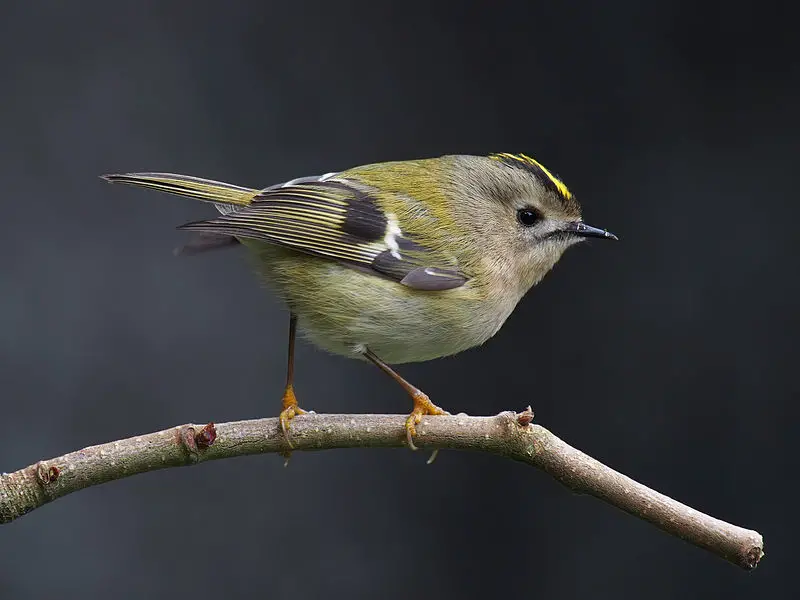
The Goldcrest is a tiny but beautiful bird from the Kinglet family. It has vibrant golden crest feathers, and it’s known as “king of birds” in European folklore.
This regal title is reflected in its scientific name R. Regulus which translates to king or knight.
The goldcrest can be found across Europe, North Africa and Asia, living mainly in coniferous forests where they feed on small insects such as aphids and caterpillars that live on tree bark or foliage.
They also eat spiders, worms and other invertebrates making them an important part of their local ecosystem by controlling pests populations while providing food for predators like hawks and owls too.
Scientific classification:
| Kingdom | Animalia |
| Phylum | Chordata |
| Class | Aves |
| Order | Passeriformes |
| Family | Regulidae |
| Genus | Regulus |
| Species | R. regulus |
14. Stock Dove
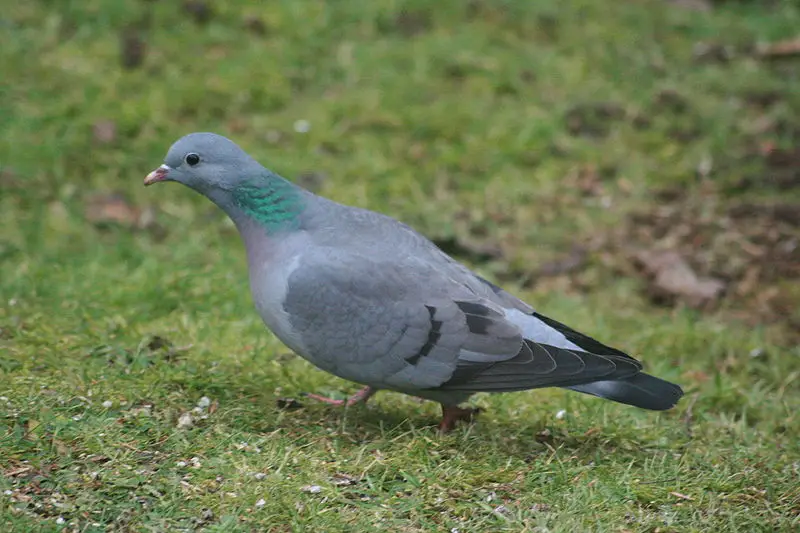
The Stock Dove is a species of bird in the Columbidae family, commonly found across the western Palearctic.
It was first documented by Swedish Naturalist Carl Linnaeus as part of his Systema Naturae publication back in 1758 and given its scientific name – Columba oenas.
Its body has an overall grey-blue colouration with darker wings, while they sport a small white patch on their neck and dark spots along their chest area.
They mainly feed on seeds but can also be seen eating insects or other invertebrates during summertime.
These birds are often heard before being spotted due to their loud cooing sound which echoes through woodlands near lakes and rivers where they typically nest; either low down in trees or sometimes even inside caves.
Scientific classification:
| Kingdom | Animalia |
| Phylum | Chordata |
| Class | Aves |
| Order | Columbiformes |
| Family | Columbidae |
| Genus | Columba |
| Species | C. oenas |
Also Featured In: Birds of Poland, Lebanon Birds Live in Semi-Desert Areas
15. Water Rail
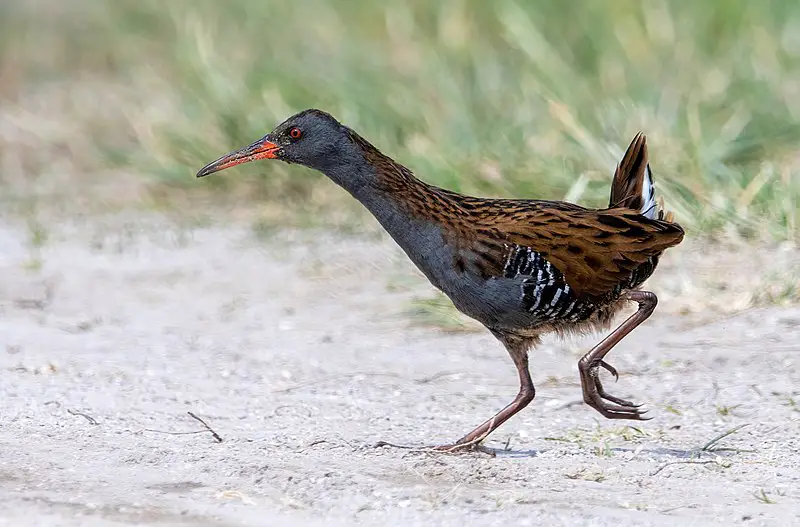
The Water rail is a member of the Rallidae bird family, which inhabits wetlands with dense vegetation. It has a flattened body to aid it in its wetland habitat; this helps it move through long grass and reeds easily.
Adults measure 23-28 cm (9-11 inches) in length and they can be found throughout Europe, Asia and North Africa.
Northern and eastern populations are migratory whereas southern ones remain permanent residents year round.
The bird’s diet consists mainly of insects, small fish, worms, molluscs as well as some plant material like grains or seeds.
Its feathers have an overall brownish grey colouration while its belly is white or creamy yellow with dark markings around the edges of each feather that gives them camouflage against their environment when seen from above or below water level respectively.
Scientific classification:
| Kingdom | Animalia |
| Phylum | Chordata |
| Class | Aves |
| Order | Gruiformes |
| Family | Rallidae |
| Genus | Rallus |
| Species | R. aquaticus |
Also Featured In: Italian Birds You Should Know, Most Common Spain Birds
16. Black-Tailed Godwit
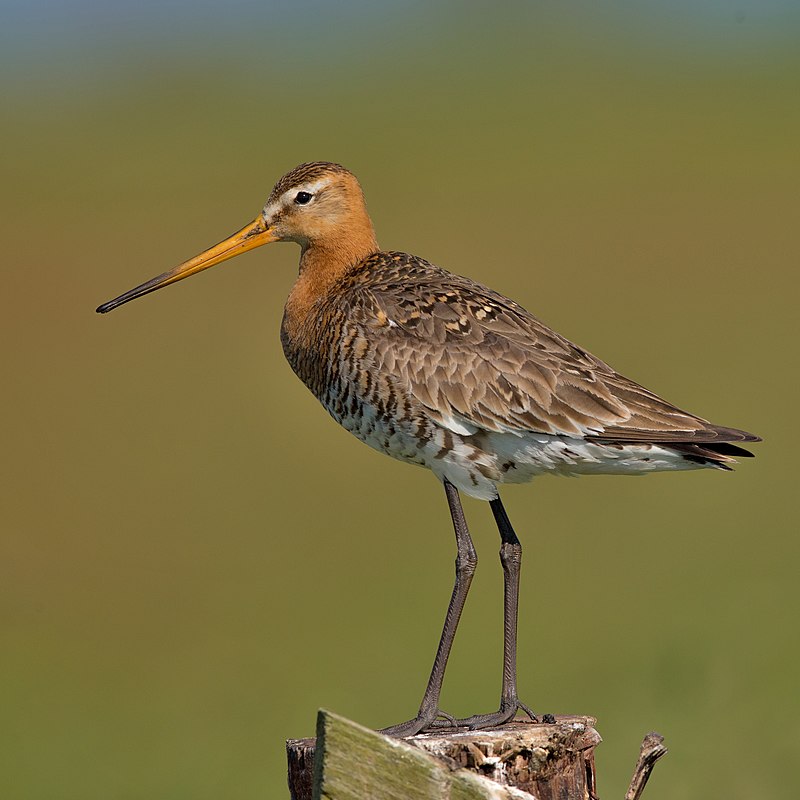
The Black-tailed Godwit is a species of large shorebird that was first described by Carl Linnaeus in 1758.
These beautiful birds have an orange head, neck and chest during breeding season while they turn to grey-brown coloration in winter.
They are easily identifiable due their black and white wingbar throughout the year. As for its habitat, these godwits breed mostly on Iceland but also across Europe, eastward through Asia Minor all the way to Mongolia; some even winter further south in Africa or India.
The Godwit has adapted well to human presence as it can be found close to wetlands near farms or villages where plenty of food is available from ploughed fields.
It’s really amazing how such a majestic bird with colorful plumage manages so successfully at this day and age.
Scientific classification:
| Kingdom | Animalia |
| Phylum | Chordata |
| Class | Aves |
| Order | Charadriiformes |
| Family | Scolopacidae |
| Genus | Limosa |
| Species | L. limosa |
Also Featured In: Birds in Sri Lanka, Estuaries Birds
17. Green Sandpiper
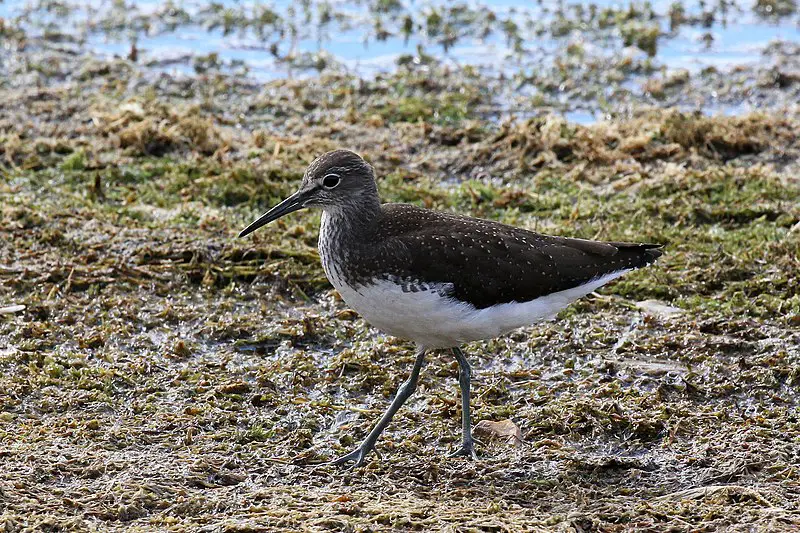
The Green sandpiper is a small Old World wader with distinctive brown wings dotted with light spots. Its neck and chest have a delicate but contrasting pattern that sets it apart from other shorebirds of its kind.
It belongs to an ancient lineage within the genus Tringa, closely related to the solitary sandpiper (Tringa solitaria).
What’s unique about these birds is their nesting habits; they nest in trees instead of on the ground like most scolopacids do.
This species can be found near bodies of water such as lakes, rivers or streams and are known for being fast fliers.
The green sandpiper makes up one part of our diverse avian population – it’s definitely worth learning more about.
Scientific classification:
| Kingdom | Animalia |
| Phylum | Chordata |
| Class | Aves |
| Order | Charadriiformes |
| Family | Scolopacidae |
| Genus | Tringa |
| Species | T. ochropus |
Also Featured In: Birds found in portugal,
18. Little Stint
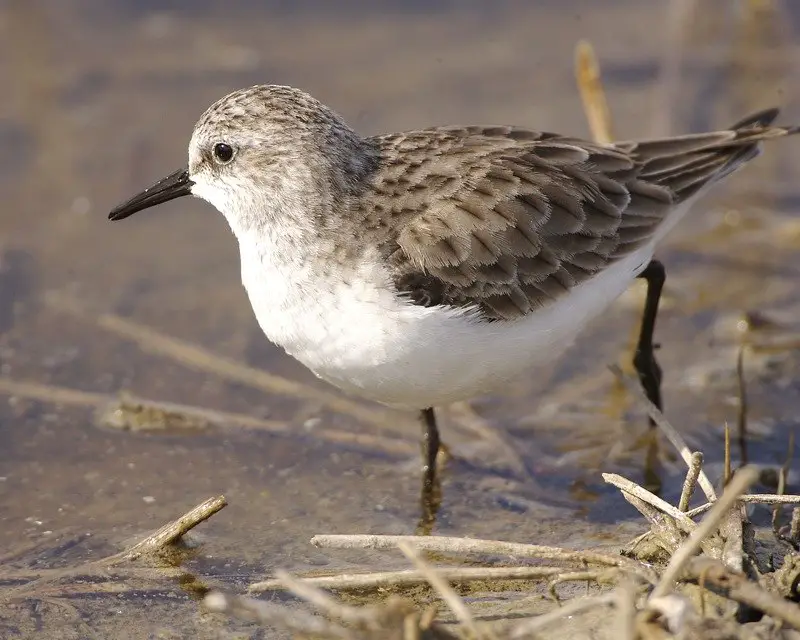
The Little Stint is an incredibly small wader that can be found in arctic Europe and Asia. During the winter it migrates to Africa and South Asia, but on rare occasions has been known to travel as far as North America and Australia.
The genus name comes from a term used by Aristotle for grey-coloured waterside birds. It’s scientific name “minuta” reflects its minuscule size when compared with other species of bird within this family.
Its feathers are mainly brownish-grey along the neck, chest and back while its belly features white streaks made up of black markings running along them horizontally.
Aside from its size, one of the most impressive traits about these birds is their ability to migrate such long distances every year.
Scientific classification:
| Kingdom | Animalia |
| Phylum | Chordata |
| Class | Aves |
| Order | Charadriiformes |
| Family | Scolopacidae |
| Genus | Calidris |
| Species | C. minuta |
Also Featured In: Oman Birds, Common United Arab Emirates Small Birds
19. Tufted Duck
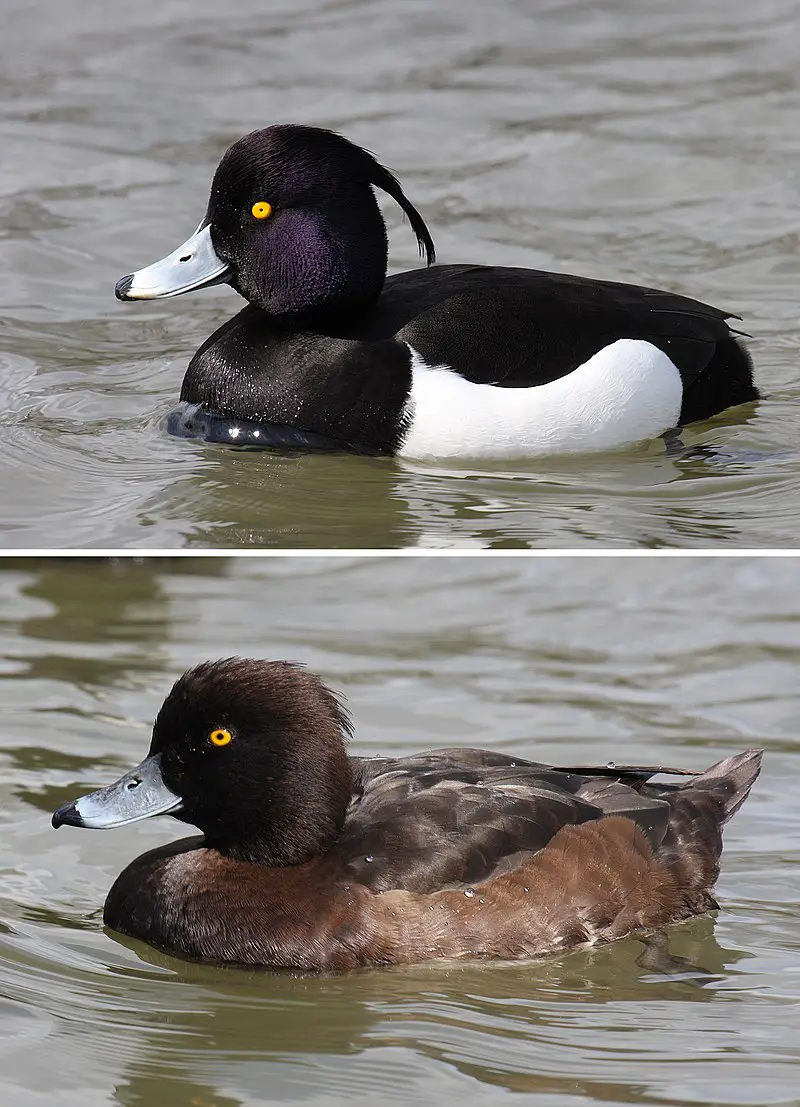
The Tufted Duck is a small diving duck which can be found in northern Eurasia, with an estimated population of nearly one million. It gets its scientific name from Ancient Greek and Latin words meaning “sooty throat”.
The adult male has black plumage except for white flanks and a blue-grey bill. Its head is also adorned by the distinctive tufts that give it its common name.
Females are brownish grey on their upper parts and have paler underparts than males as well as having orange bills instead of blue-grey ones like their male counterparts.
This species feed mainly on aquatic plants but will occasionally eat molluscs, crustaceans, insects or worms when they’re available too.
They are generally quite shy birds so keep your distance if you spot them while out in nature to avoid disturbing them unnecessarily.
Scientific classification:
| Kingdom | Animalia |
| Phylum | Chordata |
| Class | Aves |
| Order | Anseriformes |
| Family | Anatidae |
| Genus | Aythya |
| Species | A. fuligula |
Also Featured In: Kuwait Birds, East African Birds
20. Baird’s Sandpiper
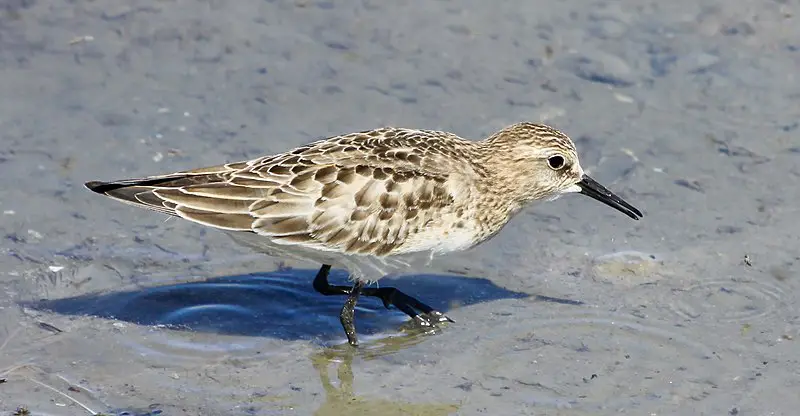
Baird’s sandpiper is a small shorebird belonging to the Calidris genus. It has grey feathers and generally inhabits waterside locations, making it highly visible in its natural environment.
This species was named after Spencer Fullerton Baird, a 19th century American ornithologist who worked with birds from across North America.
The bird is relatively widespread but may be declining in some areas due to human activity such as habitat destruction or pollution of coastal wetlands where they often reside.
As an adaptable species however, Baird’s sandpipers have been observed foraging on dry land far away from water sources during migration periods when food resources are scarce at their home grounds near waterways.
Scientific classification:
| Kingdom | Animalia |
| Phylum | Chordata |
| Class | Aves |
| Order | Charadriiformes |
| Family | Scolopacidae |
| Genus | Calidris |
| Species | C. bairdii |
Also Featured In: Grenada Birds, Birds that Live in Greenland
21. Ring-Necked Duck
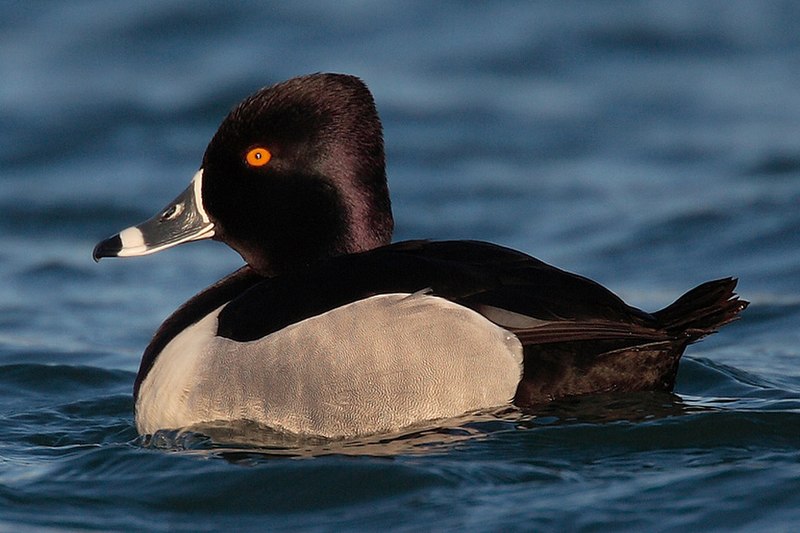
The Ring-necked duck is a popular diving bird found in freshwater ponds and lakes across North America.
They are known for their relatively small to medium size and distinctive ring around their neck, which gives them their name.
Interestingly, their scientific name is derived from a Greek word for an unidentified seabird and the Latin word for “neck.”
These ducks are great swimmers and divers, spending much of their time underwater searching for food, which mostly consists of aquatic vegetation and invertebrates.
They are also known for their striking appearance, with a beautiful coloring of black, gray, and white feathers.
The Ring-necked duck is a fascinating bird, and its unique characteristics make it a subject of interest for bird watchers and wildlife enthusiasts alike.
Scientific classification:
| Kingdom | Animalia |
| Phylum | Chordata |
| Class | Aves |
| Order | Anseriformes |
| Family | Anatidae |
| Genus | Aythya |
| Species | A. collaris |
Also Featured In: Phoenix Birds You Should Know, Common Central Park Birds
22. Western Jackdaw

The Western Jackdaw is a member of the crow family and is found throughout Europe, western Asia, and North Africa. While most populations are resident, some migrate south in the winter.
There are four subspecies, each with distinct plumage coloration. Despite being a common bird, the Western Jackdaw is a fascinating species known for its high intelligence and adaptability.
These birds have been observed using tools, working collaboratively to solve problems, and even recognizing individual human faces.
With their distinctive and varied calls, they are often heard before they are seen, chattering away in the trees or on rooftops.
Due to their remarkable intelligence and adaptability, the Western Jackdaw is widely regarded as a beloved symbol of wildlife in many cultures.
Scientific classification:
| Kingdom | Animalia |
| Phylum | Chordata |
| Class | Aves |
| Order | Passeriformes |
| Family | Corvidae |
| Genus | Coloeus |
| Species | C. monedula |
Also Featured In: Flocks Birds around Us, Ukrainian Birds You Should Know
23. Common Firecrest
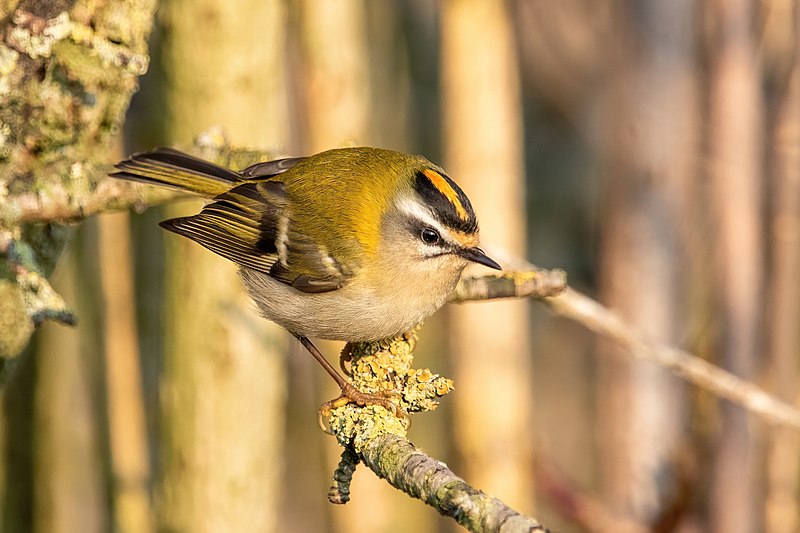
The Common Firecrest, a tiny bird from the kinglet family, is found in temperate Europe and northwest Africa. It is known for its bright orange and black striped crest which distinguishes it from other kinglets.
This bird is partially migratory, with those in central Europe moving southwards during winters.
The Firecrest breeds in different parts of its range and has a unique subspecies in the Balearic Islands and North Africa.
Despite being small, this bird has a melodious song and can be heard singing during the breeding season.
The Common Firecrest is a fascinating bird that adds color and charm to the forests and woodlands it inhabits.
Scientific classification:
| Kingdom | Animalia |
| Phylum | Chordata |
| Class | Aves |
| Order | Passeriformes |
| Family | Regulidae |
| Genus | Regulus |
| Species | R. ignicapilla |
Also Featured In: Flight Birds You Should Know, Birds of Norfolk
24. Buff-Breasted Sandpiper
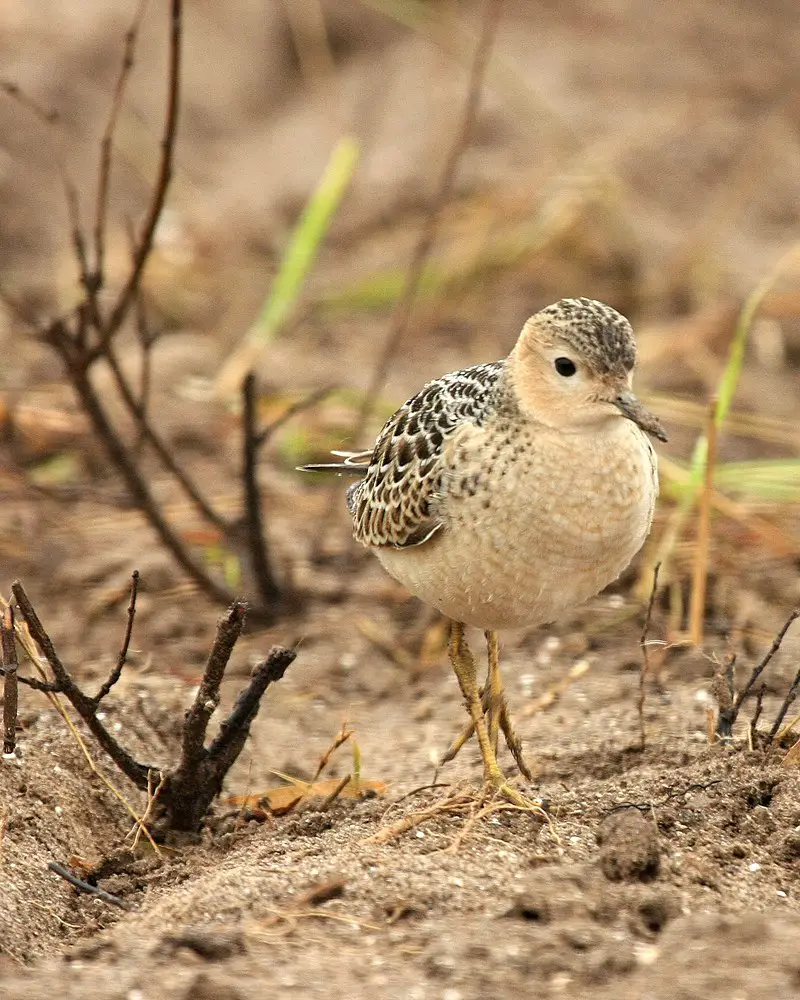
The Buff-breasted sandpiper is a tiny shorebird with a brown upper body and a buff-colored face and underparts. Its Latin name, Calidris subruficollis, means “reddish-necked” due to its somewhat rufous neck.
The bird boasts a short bill and striking yellow legs. Both males and females possess the same plumage.
It is considered a calidrid sandpiper and is a migratory bird that travels across the Americas from the Arctic tundra to South America during the breeding season.
This bird is found in open habitats, such as prairies, wet meadows, and shores. The Buff-breasted sandpiper is currently facing threats due to loss of habitat, hunting, and human disturbance.
Conservation efforts are being put in place to save this bird from extinction.
Scientific classification:
| Kingdom | Animalia |
| Phylum | Chordata |
| Class | Aves |
| Order | Charadriiformes |
| Family | Scolopacidae |
| Genus | Calidris |
| Species | C. subruficollis |
Also Featured In: Most Common Birds in South America Birds, Common Northwest Territories Birds